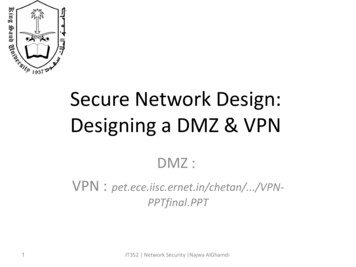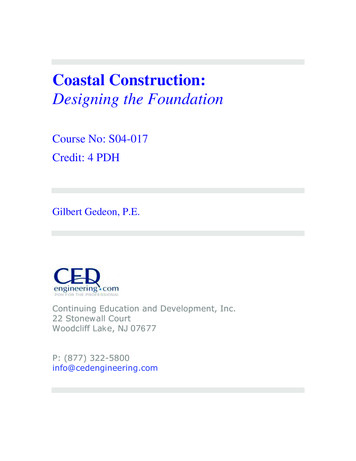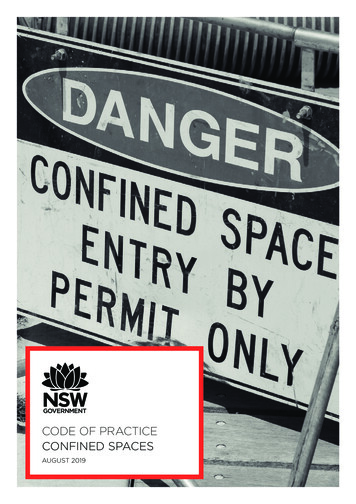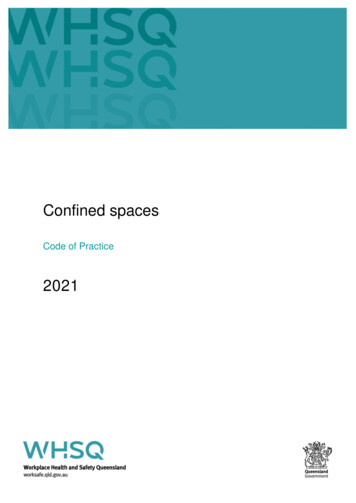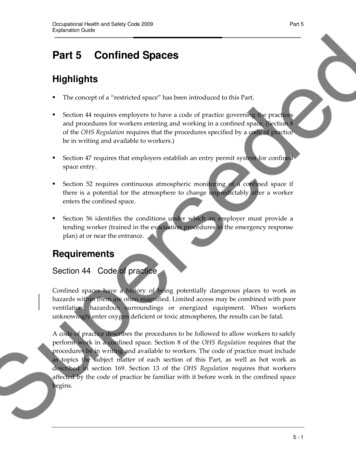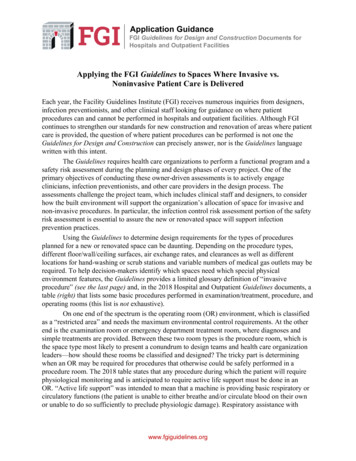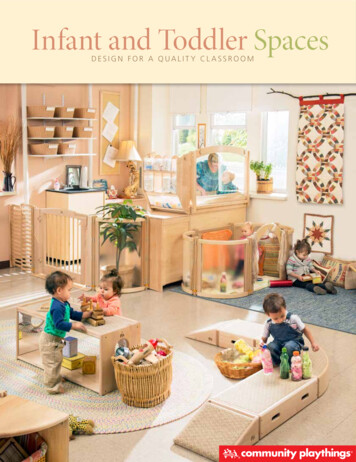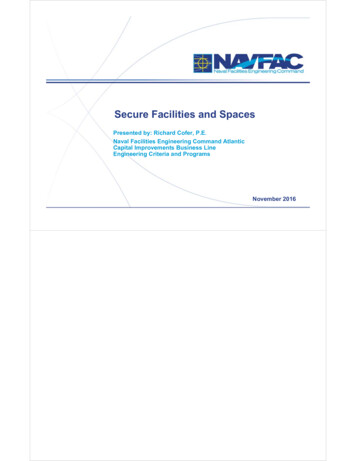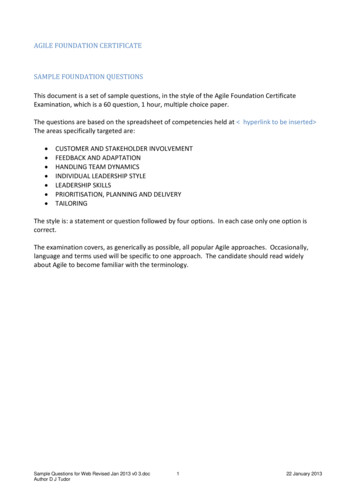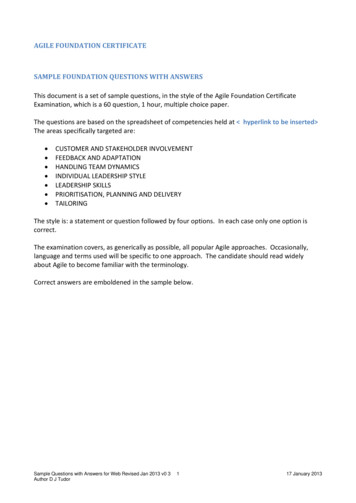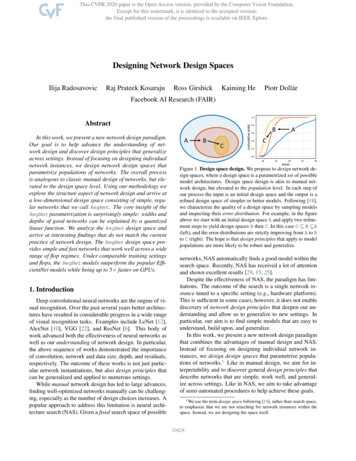
Transcription
Designing Network Design SpacesIlija RadosavovicRaj Prateek KosarajuRoss GirshickKaiming HePiotr DollárFacebook AI Research (FAIR)AbstractBIn this work, we present a new network design paradigm.Our goal is to help advance the understanding of network design and discover design principles that generalizeacross settings. Instead of focusing on designing individualnetwork instances, we design network design spaces thatparametrize populations of networks. The overall processis analogous to classic manual design of networks, but elevated to the design space level. Using our methodology weexplore the structure aspect of network design and arrive ata low-dimensional design space consisting of simple, regular networks that we call RegNet. The core insight of theRegNet parametrization is surprisingly simple: widths anddepths of good networks can be explained by a quantizedlinear function. We analyze the RegNet design space andarrive at interesting findings that do not match the currentpractice of network design. The RegNet design space provides simple and fast networks that work well across a widerange of flop regimes. Under comparable training settingsand flops, the RegNet models outperform the popular EfficientNet models while being up to 5 faster on GPUs.1. IntroductionDeep convolutional neural networks are the engine of visual recognition. Over the past several years better architectures have resulted in considerable progress in a wide rangeof visual recognition tasks. Examples include LeNet [12],AlexNet [10], VGG [22], and ResNet [6]. This body ofwork advanced both the effectiveness of neural networks aswell as our understanding of network design. In particular,the above sequence of works demonstrated the importanceof convolution, network and data size, depth, and residuals,respectively. The outcome of these works is not just particular network instantiations, but also design principles thatcan be generalized and applied to numerous settings.While manual network design has led to large advances,finding well-optimized networks manually can be challenging, especially as the number of design choices increases. Apopular approach to address this limitation is neural architecture search (NAS). Given a fixed search space of possibleAACBCFigure 1. Design space design. We propose to design network design spaces, where a design space is a parametrized set of possiblemodel architectures. Design space design is akin to manual network design, but elevated to the population level. In each step ofour process the input is an initial design space and the output is arefined design space of simpler or better models. Following [18],we characterize the quality of a design space by sampling modelsand inspecting their error distribution. For example, in the figureabove we start with an initial design space A and apply two refinement steps to yield design spaces B then C. In this case C B A(left), and the error distributions are strictly improving from A to Bto C (right). The hope is that design principles that apply to modelpopulations are more likely to be robust and generalize.networks, NAS automatically finds a good model within thesearch space. Recently, NAS has received a lot of attentionand shown excellent results [29, 15, 25].Despite the effectiveness of NAS, the paradigm has limitations. The outcome of the search is a single network instance tuned to a specific setting (e.g., hardware platform).This is sufficient in some cases; however, it does not enablediscovery of network design principles that deepen our understanding and allow us to generalize to new settings. Inparticular, our aim is to find simple models that are easy tounderstand, build upon, and generalize.In this work, we present a new network design paradigmthat combines the advantages of manual design and NAS.Instead of focusing on designing individual network instances, we design design spaces that parametrize populations of networks.1 Like in manual design, we aim for interpretability and to discover general design principles thatdescribe networks that are simple, work well, and generalize across settings. Like in NAS, we aim to take advantageof semi-automated procedures to help achieve these goals.1 We use the term design space following [18], rather than search space,to emphasize that we are not searching for network instances within thespace. Instead, we are designing the space itself.110428
The general strategy we adopt is to progressively designsimplified versions of an initial, relatively unconstrained,design space while maintaining or improving its quality(Figure 1). The overall process is analogous to manual design, elevated to the population level and guided via distribution estimates of network design spaces [18].As a testbed for this paradigm, our focus is on exploring network structure (e.g., width, depth, groups, etc.)assuming standard model families including VGG [22],ResNet [6], and ResNeXt [26]. We start with a relativelyunconstrained design space we call AnyNet (e.g., widthsand depths vary freely across stages) and apply our humanin-the-loop methodology to arrive at a low-dimensional design space consisting of simple “regular” networks, that wecall RegNet. The core of the RegNet design space is simple: stage widths and depths are determined by a quantizedlinear function. Compared to AnyNet, the RegNet designspace has simpler models, is easier to interpret, and has ahigher concentration of good models.We design the RegNet design space in a low-compute,low-epoch regime using a single network block type on ImageNet [2]. We then show that the RegNet design spacegeneralizes to larger compute regimes, schedule lengths,and network block types. Furthermore, an important property of the design space design is that it is more interpretableand can lead to insights that we can learn from. We analyzethe RegNet design space and arrive at interesting findingsthat do not match the current practice of network design.For example, we find that the depth of the best models is stable across compute regimes ( 20 blocks) and that the bestmodels do not use either a bottleneck or inverted bottleneck.We compare top R EG N ET models to existing networksin various settings. First, R EG N ET models are surprisinglyeffective in the mobile regime. We hope that these simple models can serve as strong baselines for future work.Next, R EG N ET models lead to considerable improvementsover standard R ES N E (X) T [6, 26] models in all metrics.We highlight the improvements for fixed activations, whichis of high practical interest as the number of activationscan strongly influence the runtime on accelerators such asGPUs. Next, we compare to the state-of-the-art E FFICIENTN ET [25] models across compute regimes. Under comparable training settings and flops, R EG N ET models outperform E FFICIENT N ET models while being up to 5 faster onGPUs. We further test generalization on ImageNetV2 [20].We note that network structure is arguably the simplestform of a design space design one can consider. Focusingon designing richer design spaces (e.g., including operators)may lead to better networks in future work.We strongly encourage readers to see the extended version of this work on arXiv2 and also to check the code3 .2 https://arxiv.org/abs/2003.136783 https://github.com/facebookresearch/pycls2. Related WorkManual network design. The introduction of AlexNet [10]catapulted network design into a thriving research area.In the following years, improved network designs wereproposed; examples include VGG [22], Inception [23,24], ResNet [6], ResNeXt [26], DenseNet [8], and MobileNet [7, 21]. The design process behind these networkswas largely manual and focussed on discovering new designchoices that improve accuracy e.g., the use of deeper modelsor residuals. We likewise share the goal of discovering newdesign principles. In fact, our methodology is analogous tomanual design but performed at the design space level.Automated network design. Recently, the network designprocess has shifted from a manual exploration to more automated network design, popularized by NAS. NAS hasproven to be an effective tool for finding good models,e.g., [30, 19, 14, 17, 15, 25]. The majority of work in NASfocuses on the search algorithm, i.e., efficiently finding thebest network instances within a fixed, manually designedsearch space (which we call a design space). Instead, ourfocus is on a paradigm for designing novel design spaces.The two are complementary: better design spaces can improve the efficiency of NAS search algorithms and also leadto existence of better models by enriching the design space.Network scaling. Both manual and semi-automated network design typically focus on finding best-performing network instances for a specific regime (e.g., number of flopscomparable to ResNet-50). Since the result of this procedure is a single network instance, it is not clear how to adaptthe instance to a different regime (e.g., fewer flops). A common practice is to apply network scaling rules, such as varying network depth [6], width [27], resolution [7], or all threejointly [25]. Instead, our goal is to discover general designprinciples that hold across regimes and allow for efficienttuning for the optimal network in any target regime.Comparing networks. Given the vast number of possiblenetwork design spaces, it is essential to use a reliable comparison metric to guide our design process. Recently, theauthors of [18] proposed a methodology for comparing andanalyzing populations of networks sampled from a designspace. This distribution-level view is fully-aligned with ourgoal of finding general design principles. Thus, we adoptthis methodology and demonstrate that it can serve as a useful tool for the design space design process.Parameterization. Our final quantized linear parameterization shares similarity with previous work, e.g. how stagewidths are set [22, 5, 27, 8, 7]. However, there are two keydifferences. First, we provide an empirical study justifyingthe design choices we make. Second, we give insights intostructural design choices that were not previously understood (e.g., how to set the number of blocks in each stages).10429
0.83.1. Tools for Design Space DesignWe begin with an overview of tools for design space design. To evaluate and compare design spaces, we use thetools introduced by Radosavovic et al. [18], who propose toquantify the quality of a design space by sampling a set ofmodels from that design space and characterizing the resulting model error distribution. The key intuition behind thisapproach is that comparing distributions is more robust andinformative than using search (manual or automated) andcomparing the best found models from two design spaces.error0.6Our goal is to design better networks for visual recognition. Rather than designing or searching for a single bestmodel under specific settings, we study the behavior of populations of models. We aim to discover general design principles that can apply to and improve an entire model population. Such design principles can provide insights intonetwork design and are more likely to generalize to new settings (unlike a single model tuned for a specific scenario).We rely on the concept of network design spaces introduced by Radosavovic et al. [18]. A design space is a large,possibly infinite, population of model architectures. Thecore insight from [18] is that we can sample models froma design space, giving rise to a model distribution, and turnto tools from classical statistics to analyze the design space.We note that this differs from architecture search, where thegoal is to find the single best model from the space.In this work, we propose to design progressively simplified versions of an initial, unconstrained design space. Werefer to this process as design space design. Design spacedesign is akin to sequential manual network design, but elevated to the population level. Specifically, in each step ofour design process the input is an initial design space andthe output is a refined design space, where the aim of eachdesign step is to discover design principles that yield populations of simpler or better performing models.We begin by describing the basic tools we use for designspace design in §3.1. Next, in §3.2 we apply our methodology to a design space, called AnyNet, that allows unconstrained network structures. In §3.3, after a sequence of design steps, we obtain a simplified design space consisting ofonly regular network structures that we name RegNet. Finally, as our goal is not to design a design space for a singlesetting, but rather to discover general principles of networkdesign that generalize to new settings, in §3.4 we test thegeneralization of the RegNet design space to new settings.Relative to the AnyNet design space, the RegNet design space is: (1) simplified both in terms of its dimensionand type of network configurations it permits, (2) containsa higher concentration of top-performing models, and (3) ismore amenable to analysis and interpretation.0.40.20.0[39.0 49.0] AnyNetX40455055error606570706060error1.0cumulative prob.3. Design Space ure 2. Statistics of the AnyNetX design space computed withn 500 sampled models. Left: The error empirical distributionfunction (EDF) serves as our foundational tool for visualizing thequality of the design space. In the legend we report the min errorand mean error (which corresponds to the area under the curve).Middle: Distribution of network depth d (number of blocks) versus error. Right: Distribution of block widths in the fourth stage(w4 ) versus error. The blue shaded regions are ranges containingthe best models with 95% confidence (obtained using an empiricalbootstrap), and the black vertical line the most likely best value.To obtain a distribution of models, we sample and trainn models from a design space. For efficiency, we primarilydo so in a lo
network design spaces, it is essential to use a reliable com-parison metric to guide our design process. Recently, the authors of [18] proposed a methodology for comparing and analyzing populations of networks sampled from a design space. This distribution-level view is fully-aligned with our goal of finding general design principles. Thus, we adopt .
